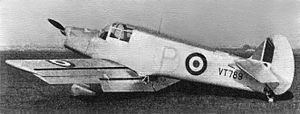Top speed 290 km/h Length 8.84 m First flight February 5, 1948 Designer L. E. Baynes | Wingspan 10 m Retired 1954 | |
 | ||
The Youngman-Baynes High Lift was a British, experimental aircraft of the 1940s. It was a single-engine, low-wing monoplane with a fixed tailwheel undercarriage.
Contents
Development
The High Lift was a "one-off" experimental, flying test-bed for the system of slotted flaps invented by R.T. Youngman. It was designed by L. E. Baynes AFRAeS, using components from the Percival Proctor, and built by Heston Aircraft Company Ltd. Test pilot Flight Lieutenant Ralph S Munday piloted the first flight at Heston Aerodrome on 5 February 1948, carrying the military serial VT789.
Operational history
The High Lift was registered as G-AMBL on 10 May 1950. Its career ended in 1954 when it was presented to the College of Aeronautics at Cranfield.
Specifications
Data from
General characteristics
Performance
References
Youngman-Baynes High Lift Wikipedia(Text) CC BY-SA
